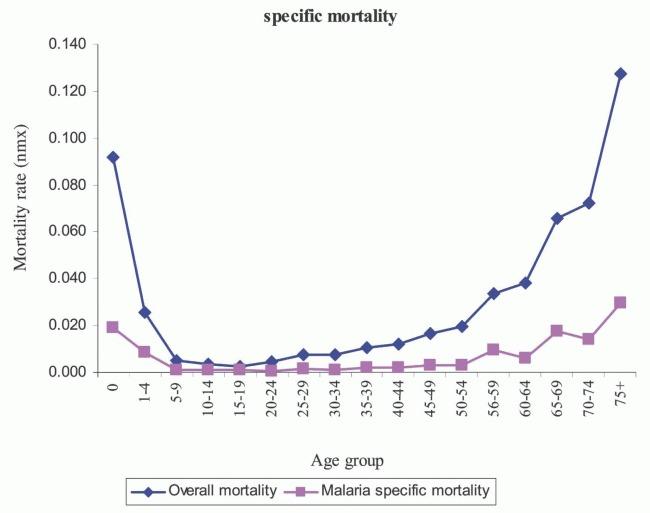Specific mortality with malaria
Image 
The specific mortality of a person with malaria shows that it is a disease that primarily attacks children and the elderly. The attached graphic, from the study ['How Many Years of Life Could Be Saved If Malaria Were Eliminated from a Hyperendemic Area of Northern Ghana?'] (Http://www.gphysics.net/downloads/medicine/Bookshelf_NBK1712.pdf) Ayaga A. Bawah and Fred N. Binka shows mortality according to age with and without malaria:

ID:(8215, 0)
Life expectancy with malaria
Image 
The average life expectancy of a person with malaria is reduced on average by approximately 10 years. The attached graphic, from the study ['How Many Years of Life Could Be Saved If Malaria Were Eliminated from a Hyperendemic Area of Northern Ghana?'] (Http://www.gphysics.net/downloads/medicine/Bookshelf_NBK1712.pdf) Ayaga A. Bawah and Fred N. Binka shows life expectancy according to age with and without malaria:

ID:(8214, 0)
Statistics of mosquito and bite populations
Image 
In the article ['Human-to-mosquito transmission effciency increases as malaria is controlled'] (http://www.gphysics.net/downloads/medicine/Churcher_et_al-2015-Nature_Communications.pdf) by Thomas S. Churcher, Jean- Francois Trape and Anna Cohuet in Nature Communications published on January 19, 2015 look at the curves seen in the image below:

We rescue that the fraction of mosquitoes
On the other hand about 30 bites per month are observed. Therefore the probability of daily bite
If you think about measures you can study the years in which the number of bites receded and determine the cause of this. As an example, if it were detected that in a year of drought the rate falls, it could be concluded that with drainage measures, areas prone to inhabit mosquitoes with malaria can be dried. In this case, the data of said favorable years can be taken to determine a set of data that would be given in the case of taking measures. This is how a reduction of 30 to 15 bites per month would lead to measures that the probability of being bitten
Note: It is important to keep in mind that the
ID:(8199, 0)
Estimation of human contagion probabilities
Equation 
If the asymptotic situation of a population of humans with malaria is known, the equations can be used
| i_{\infty}=\displaystyle\frac{\Lambda p_b^2p_Ip_V-\mu\gamma}{p_bp_V(\gamma+\Lambda p_bp_I)} |
and
| v_{\infty}=\displaystyle\frac{\Lambda p_b^2p_Ip_V-\mu\gamma}{\Lambda p_bp_I(\mu+p_bp_V)} |
to determine
| p_i=\displaystyle\frac{\gamma i}{(1-i)p_b v \Lambda} |
ID:(8211, 0)
Estimation of mosquito contagion probabilities
Equation 
If the asymptotic situation of a population of humans with malaria is known, the equations can be used
| i_{\infty}=\displaystyle\frac{\Lambda p_b^2p_Ip_V-\mu\gamma}{p_bp_V(\gamma+\Lambda p_bp_I)} |
and
| v_{\infty}=\displaystyle\frac{\Lambda p_b^2p_Ip_V-\mu\gamma}{\Lambda p_bp_I(\mu+p_bp_V)} |
to determine
| p_v=\displaystyle\frac{\mu v}{p_b i(1-v)} |
ID:(8212, 0)
Country statistics
Description 
Population:
Year | Sick | Deaths
: -----: |: -------: |: ---------:
2000 | 3349528 | 6108 |
2001 | 3044844 | 1717 |
2002 | 3140893 | 2376 |
2003 | 3552896 | 2103 |
2004 | 3416033 | 1575 |
2005 | 3452969 | 2037 |
2006 | 3511452 | 3125 |
2007 | 3123147 | 4622 |
2008 | 3200147 | 3889 |
2009 | 3694671 | 3378 |
2010 | 3849536 | 3859 |
2011 | 4154261 | 3259 |
2012 | 10676731 | 2855 |
2013 | 7200797 | 2506 |
2014 | 8453557 | 2200 |
ID:(9664, 0)
Probability estimate
Description 
If it is assumed that the number of bites is one per day (
| p_i=\displaystyle\frac{\gamma i}{(1-i)p_b v \Lambda} |
that
| p_v=\displaystyle\frac{\mu v}{p_b i(1-v)} |
that
ID:(8213, 0)
Malaria Simulator
Php 
The simulator for the case of malaria allows to experiment with the different parameters and observe how the populations of infected humans and mosquitoes develop:
ID:(9660, 0)
